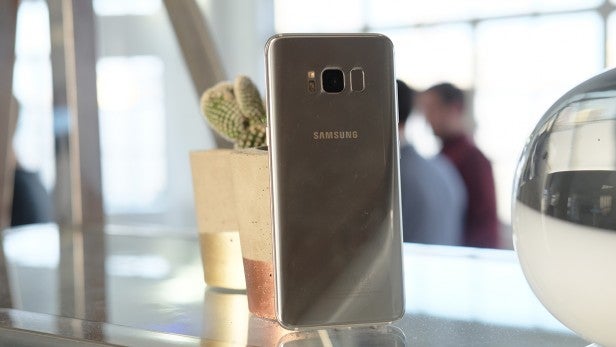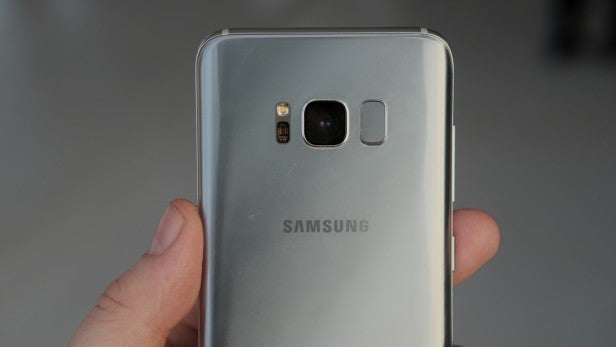Samsung Galaxy S8 Review - Performance and Software Review
Performance and Software Review
This is the future of phones

Sections
- Page 1 Samsung Galaxy S8 Review
- Page 2 Performance and Software Review
- Page 3 Camera Review
- Page 4 Battery Life and Verdict Review
Samsung Galaxy S8 – Performance
Under the stunning body is a serious amount of power, although where you live in the world will determine the SoC (system-on-chip) at the heart of the device. Brits, and those in Europe and Asia, will get Samsung’s own Exynos 8895 chipset, while folk in the USA will get a device with the Qualcomm Snapdragon 835.
Whichever CPU you end up with is unlikely to make a huge difference on performance. But considering I’ve so far used only the Exynos version, I can’t say too much about the 835.
Both are the fastest CPUs out there, built using a 10nm production process for improved efficiency. There’s 4GB of RAM – any more is basically pointless for a phone at this stage – and it has a roomy 64GB of internal storage with support for up to 256GB microSD cards.
During my time with the Galaxy S8, I can’t say that it’s been noticeably faster than a Snapdragon 821 device such as the Pixel XL or LG G6. However, the latest processors do add in a few features that are aiming to future-proof devices such as this.
Related: Best Android Phones

There’s Gigabit LTE support, better battery life relative to the cell used, and the ability for quicker charging. Having more power also makes it possible to enlist DeX, Samsung’s way of turning the S8 into a mini-computer that can be plugged into an HDMI monitor.
Another future-looking feature is Bluetooth 5.0, which you won’t be able to take advantage of fully until relevant devices with it are released. But, for now at least, you can finally pair two Bluetooth-enabled devices to the S8 at once and play music through both of them.
Nothing seems to make the Galaxy S8 break sweat – but that in itself isn’t a big deal any more. The £400 OnePlus 3T will handle most tasks you throw at it, as will the £160 Moto G5.
Games run as you’d expect from a flagship phone running the latest GPUs – the Mali G71 for the Exynos model and the Adreno 540 for the Snapdragon; they load quickly and play without any dropped frames. However, there hasn’t been a huge jump in the quality and power needed to run these intensive games since the Galaxy S7 arrived. DeX will be a real test of the phone’s power, but I haven’t had much time to test this yet.
There’s a bigger gap in performance in synthetic benchmark tests, where the Galaxy S8 scores 2013 in the Geekbench 4’s single-core test and 6659 in the multi-core version. That’s on a par with results from a test Snapdragon 835, and slightly above phones running the Kirin 960, which scores 1935 and 6237 in the same tests.
I would have liked to have seen better single-core scores, since the majority of daily tasks utilise only this. The iPhone remains at the top in this category, with its 3434 single-core score.

In the AnTuTu benchmark, which tests everything from 3D performance to RAM speeds, the S8’s 173,292 score is among the best. Notably, its 70,546 score in the 3D gaming tests put it above the iPhone 7 Plus and LG G6, which both scored 60,000.
Unfortunately, speakers still don’t appear to be a priority for Samsung – the downward-facing one here is terrible. It’s easy to block with your hand when you’re watching landscape video, and the sound itself is tinny and distorted at higher volumes. With the diminishing bezel, it’s likely that speakers will continue to get worse. Phone-call quality is fine, as is Wi-Fi performance, but neither is revolutionary or better than what you’d experience on much cheaper phones.
The Galaxy S8 is a fast handset – but I increasingly expect that, rather than being surprised by it. The chip-makers are advancing much faster than the apps for these flagships, and it does feel as though much of the power available here is probably wasted.
Samsung Galaxy S8 – Software
Software used to be one of Samsung’s weaknesses, and although far from being one of the company’s strengths in the S8, improvements are clear to see.
In fact, the software layer on top of Android 7.0 is good-looking and functional. Icons are more mature, and the on-screen buttons – a first for a Samsung S-series phone – are angular and edgy. I’m particularly a fan of the haptic feedback you get when you push the virtual home button, which can be accessed even when the display is off.
The stark white colour scheme is clean and crisp, and all of Samsung’s native apps have adapted that look. Google Assistant is on board, although there’s no Daydream support, since that sort of clashes with the newly updated Gear VR and its snazzy motion controller.
The biggest software addition for the Galaxy S8 is Bixby, Samsung’s rival to Siri – and it’s probably the biggest disappointment, too. This digital personal assistant pops up everywhere, plus there’s a dedicated Bixby button on the side, so you don’t need to call out an awkward phrase to get it going. The thing is, it feels half-baked and not quite ready yet.

The left-most homescreen is Bixby’s home – but mostly, it just mimics Google Now. It will throw up some news, maybe a reminder to ring Mum, and push some funny YouTube videos, but we’ve seen this all before. You can’t even talk to Bixby yet, which appears to be a basic omission – and when it finally does arrive later in the spring, it will be limited to US English and Korean.
Bixby does have one redeeming feature. In the camera app, it will let you snap a picture of an item and use the AI to either find similar items, or get you a link to buy it. Again, this isn’t new, but at least there’s some use there.
Bixby feels like multiple different features thrown together, each of which is already part of Android. Maybe in the future it will improve, but for now there’s a handy option to turn it off.
Another new software feature is ‘DeX’. I like to think of this as ‘Microsoft Continuum, if it wasn’t terrible’.
Like Continuum, DeX requires a sold-separately dock that connects to an HDMI-equipped monitor and turns your Galaxy S8 into a mini-PC. The dock also has power, two USB-A ports and an Ethernet connector, along with a smattering of fans in the base to keep the phone from becoming too hot.
If you connect the phone via the USB-C port inside the cradle, a new desktop – which looks a lot like Windows 10 – pops up. Your apps are displayed in a very familiar layout and there’s a software dock along the bottom that lets you access all the phone and text functions of the phone.

What makes this so much better than Continuum is app support. Apps are resizable and bounce between phone and tablet versions depending on how much you stretch them, and you can multiple apps open at the same time.
My time with DeX so far has been limited, so I’m going to use it a little more before I deliver my final verdict on it.
Samsung has done a great job to make the transition from a 16:9 aspect ratio to the 18.5:9 here as seamless as possible. Most Android apps scale perfectly, but you can manually stretch those that don’t. Most of the games I’ve tested needed to be manually stretched, but I’d happily take this over having two black bars at each end.
Video has the potential to be the stickiest area – but again, clever software tricks provide a solution. Take YouTube, for instance – a place where most videos are displayed in 16:9 On the S8, when you’re watching a YouTube video, a box will pop up and give you the option to crop in to fill the whole screen and make better use of the space. As with anything cropped, you’re likely to lose some parts of the picture, but at least the option is there. There’s less of an issue with movies, though, since these tend to already be shot at wider aspect ratios.
Samsung has been playing about with a few different biometric methods of unlocking the phone for a while now, but they all seem to finally come together in the Galaxy S8. And they sort of need to, especially if you dislike the position of the fingerprint scanner as much as I do.

The iris scanner from the Note 7 is present, but it’s much faster; and there’s a less secure – but even quicker – face-recognition tool. The iris scanner is good, but I find having to look directly at the camera every time I unlock the phone something of a chore. The facial recognition is faster, when you’ve finally got it to recognise your face, but it can easily be fooled by a photo. Neither is perfect, but at least you can combine them with the fingerprint scanner and a more traditional pattern unlock.
Would I like an easier-to-reach fingerprint sensor and none of the extra stuff? Of course. But it wouldn’t stop me from buying, or recommending, this phone.
How we test phones
We test every mobile phone we review thoroughly. We use industry standard tests to compare features properly and we use the phone as our main device over the review period. We’ll always tell you what we find and we never, ever, accept money to review a product.


